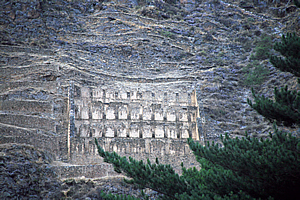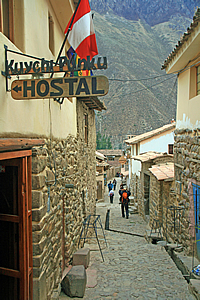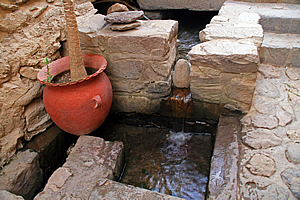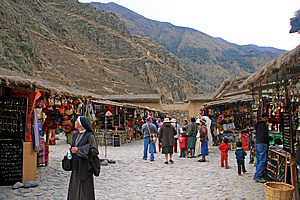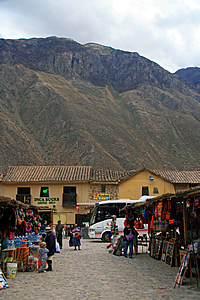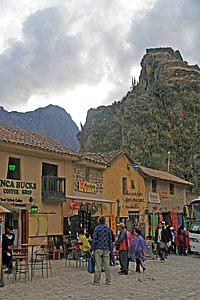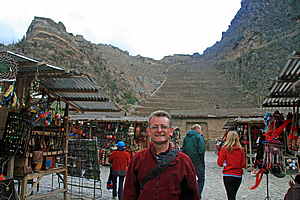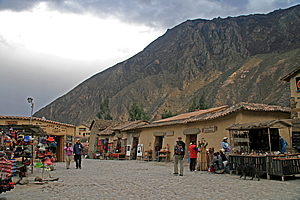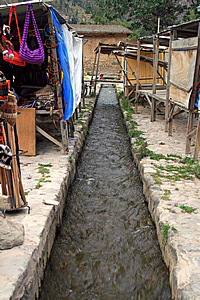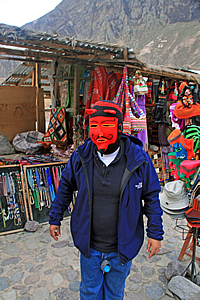--- Archive files ---
Home > Treks > Inca Trail > Day 2 > 2.4 |
Ollantaytambo
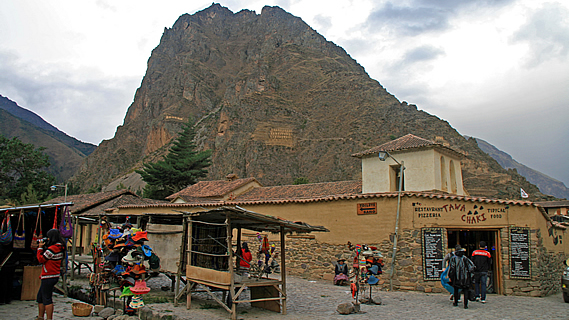
IT WAS about twenty minutes after leaving the abandoned market stall and zig zagging down the precarious ravine when we finally reached the bottom of the Sacred Valley, where we crossed the swift flowing Urubamba River across a steel suspension bridge. We drove through the bustling town over cobbled roads before quickly returning to farmland heading north downstream. The potatoes seemed to be growing very well down here at 2700 metres above sea level.
We continued travelling down the relatively flat bottom of the glacial valley. The valley itself began to get narrower as the surrounding hills steepened to sheer barren cliffs towering some two kilometres high on either side.
Soon the valley became very narrow to the point I could see that it completely closed in ahead of us. We turned to the right to follow an Incan wall uphill towards the edge of the valley. The road had suddenly become cobblestones as it had been in the area near our hotel in Cuzco.
Carvings in the cliff face above Ollantaytambo |
About a hundred metres short of the cliff, the road turned to the left and we passed through a low stone wall entering the small town of Ollantaytambo. We were only a few metres inside the entrance when we stopped at the back of a traffic jam. Apparently a couple of buses had become stuck further ahead and were trying to get out. It was ironic coming across a traffic jam here as the road had been very quiet and almost traffic free up till now.
A few vehicles stopped behind us locking us in. We stayed there for about ten minutes before starting to crawl again. We inched forward about ten metres before grinding to a halt. Here we waited for another fifteen minutes before we started to move again. This time we moved about eighty metres before coming to a stop again.
We were trapped in the traffic jam on a narrow cobblestone road with stone houses tightly packed on either side of us. A deep channel with a swift flowing canal of crystal clear mountain water raced past us on the other side of the road. The houses rose vertically from the channel without even the slightest hint of a front yard. The buildings had stone construction about half way up, then smaller stones the rest of the way up to the roof. Each house had a stone slab crossing the channel to the blue painted wooden door entrance which was always closed. Most houses had some form of advertising on them, whether they were small printed signs or large graffiti in bright red paint promoting political parties or businesses. I assumed the owners of these houses would get paid for the advertising.
Narrow lane |
Finally after another twenty minutes of waiting we saw a few people walking past us. They had left their buses and had decided to walk the rest of the way. We asked Luis how far the hotel was. He said It was only about ten minutes walk away, so we all decided to get out and walk the rest of the way.
Light drizzle was falling from the gloomy clouds overhead as we put on our packs and started weaving our way through the tightly packed mass of vehicles. Thankfully it wasn’t freezing cold though like it had been up at the abandoned market or at the potato farming village. A few minutes later we reached a large open area where the buses were attempting to turn around to get out. We managed to walk pass them and follow a quieter road through a shopping area to an outdoor market with rows of many stalls. Behind the market were some amazing archaeological sites clinging to the near vertical faces of the towering cliffs, but we were getting a bit tired from carrying out packs, so before I could take it all in, we turned off to the left down a very narrow alleyway. There was just a narrow footpath and a stone canal with crystal clear flowing in it in between all the buildings.
Water channel |
We reached our accommodation - the Kuychi Punku Hostal about thirty metres along the alleyway. The entrance and reception area were quite dark, but it opened out into a small charming courtyard with the dining hall at the far end. The entrance and courtyard had all sorts of Incan artefacts in it surrounded by plants a little overgrown. There were two storeys of rooms on either side with the stairs to the second level going off to the right. I got my key from Luis and headed upstairs in the courtyard to my room, which was at the top of the stairs.
I entered the room. The walls were stark white with one feature wall coloured a rusty maroon, but fortunately were cheered up somewhat by the very brightly rusty orange bedspreads on the two single beds. The ceiling of this room was very high making it appear a little too small. A basic ensuite was to the right behind the feature wall. The toilet and basin were a hideous dark maroon colour again clashing terribly with the white tiles. There were no pictures on the walls creating an eerily claustrophobic environment.
I unpacked everything onto one of the beds and relaxed for a few minutes before exploring the village.
Markets |
I left the hotel, walking along the narrow alleyway with the running water down the narrow canal. The water was crystal clear and the channel was in perfect condition. It certainly wasn’t like the plumbing we have these days. This has been here in perfect running order for around five hundred years and still in perfect condition. The water bubbled from one small square pool to the next, each pool no doubt having a function for collecting water. Between each pool the water ran through a narrow channel of five to ten centimetres wide. Some of these channels had a stone in it and they all had stones sitting on the ledge beside them to control the flow of water. The channel would occasionally cross the alley, so you’d need to watch where you were going if you were walking down here at night.
Markets |
Markets |
I walked out of the alleyway into the village market area, meeting the rest of the group who had already gathered here. In front of me was a large market area selling all sorts of things including clothing, souvenirs, and musical instruments. The market stalls were just rows of rusty corrugated iron roofing held up by timber poles, although that was hardly noticeable given the vibrancy of the brightly coloured merchandise cluttering each stall.
Markets |
To the left the road was clear to a large block wall marking the start of the Ollantaytambo archaeological site. There were people walking there – many hundreds of them walking in a continuous line. Luis said there really wasn’t much to see up there. The sites that we will be visiting along the trail are far more interesting and a lot less crowded.
Luis started telling us about the town. We were two thousand seven hundred and ninety two metres above sea level – about the same altitude at the summit of Mount Ruapehu, the North Island’s highest mountain.
Markets |
During Incan times in the mid fifteenth century, this was te royal estate of Emperor Pachacuti who conquered the region, and built the town as a ceremonial centre.
The town is based where the Patajkancha River comes out of an arid precipitous gorge into the Sacred Valley to meet the Urubamba River. Although the highly fortified ruins resembled a military settlement, In stark contrast it was built mainly for religious purposes. However the city was used successfully as a defence base during the Spanish conquest of Peru, the town served as the stronghold for Manco Inca Yupanqui, the leader of the Inca resistance.
Ollantaytambo’s name remains a mystery, but the tambo part of the name essentially means an inn to stay in and to stock up on supplies for long journey. That was very appropriate for us as this was our final base before starting the Inca trail tomorrow and we were about to get our final supplies.
Small canal |
Luis mentioned the local rock here is rather soft and not suitable for building, so the rock used to build this city was granite excavated about five kilometres away and brought here. That was pretty impressive particularly as the Inca did not have the wheel that aided many other advanced early civilisations.
To the right was a long straight canal where a significant stream flowed swiftly towards us, having been diverted from the Patajkancha River a few hundred metres upstream. This channel disappeared under the cobblestone road and would have split to feed all the smaller channels going along the side of the road, and down the little channels down each alley. The valley came around a large cliff formation carved out during the last ice age. Luis pointed up the cliff to the remains of another village, with houses carved into the rock.
The pale brown mountains made a magnificent backdrop for the markets at the bottom of the glacial valley. We explored them and I looked for something to buy. I brought Luis over to a couple of stalls and asked what I should offer for some of the souvenirs. He said these things were a bit too expensive, so I kept looking. Nothing really got my fancy in the markets, so I walked over to the shops in the main market close to the hotel. Here I saw one good shop that was selling metal souvenirs of a high quality, including some Incan wind chimes. I brought Luis back and he helped me negotiate a good price for a very nice Incan wind chime. Nothing like a little local help.
Luis in disguise |
We all regrouped randomly. Michael was showing good spirits for the first time since getting food poisoning in the Amazon. He put on a bright green woollen devil’s hat. We all photographed him. Then Luis found an even more devilish balaclava coloured red and black and put it on. He was quite a sight wearing this hat and also having his big water bottle stuck between his legs. It was crazy.
Anyway, the fun at the markets had to conclude now. The cloudy sky was turning purple with the sun setting over the horizon hidden behind the mountains, so it was time for us to have dinner and settle for the night.
Everyone else in my group wanted pizza. That’s not the best thing to eat on the eve of a big hike, but the majority vote ruled and we found a pizza place. We climbed up a rather rickety spiral staircase up one of the buildings and entered the very dark restaurant. There seemed to be a lot of very nice paintings on the walls, but I could never tell – it was too dark in here.
They seemed to be very disorganised in there despite us being the only group there. We all ordered. I ordered a basic meat pizza medium size. I’m sure that wouldn’t have been a difficult order to have filled. I had also ordered an Inca Cola. This is very different from Coke. It is a pale yellowish green colour and tastes really nice – not like the other colas I had tried in the past.
The staff spent ages in the kitchen cooking up our pizzas. Finally they started coming out one at a time. I waited and waited and waited. Soon it seemed evident that a couple of us were going to miss our orders. Luis went into the kitchen to sort them out, and finally they started bringing out more pizzas one at a time.
Finally an hour and a half after ordering, my pizza arrived. I heard one of the ladies Marissa (a Chilean national living in London who was the only Spanish speaking member of our group) mumbling there was no way they were going to be paying a tip. Gosh, I had never even thought of a tip. The pizzas were very ordinary - stale cheese on reconstituted cardboard with only a few tiny things on top wasn’t what any of us had in mind. I thought you’d only get such poor service and such poor quality food in Australia.
I was very relieved to finally get out of there. It was getting quite late thanks to all that waiting around. I was happy to return to the hotel and get into bed. This will be the last bed I’m going to sleep in for several days, so I made the most of the comfort.
The shower cubicle and hand basin were a hideous dark purple colour, and the soap initially seemed very basic, but it was good soap so I thought, as it wiped away the final remnants of the temporary tattoo the Shaman had painted on the back of my left hand a couple of days ago deep in the Amazon. Good to see it was finally clean.
<< Previous | Next >> |
|
||
About this Page
|
||
|
|
|
Where is Walkabout Jeff? |
|
|
|
|
What is happening in Walkabout Jeff's hometown?
|
|
|
|
|
Who is Walkabout Jeff?Any normal person's idea of going out involves going to the local pub for a drink with a few mates. Walkabout Jeff isn't normal.
|
|
|
|
|
